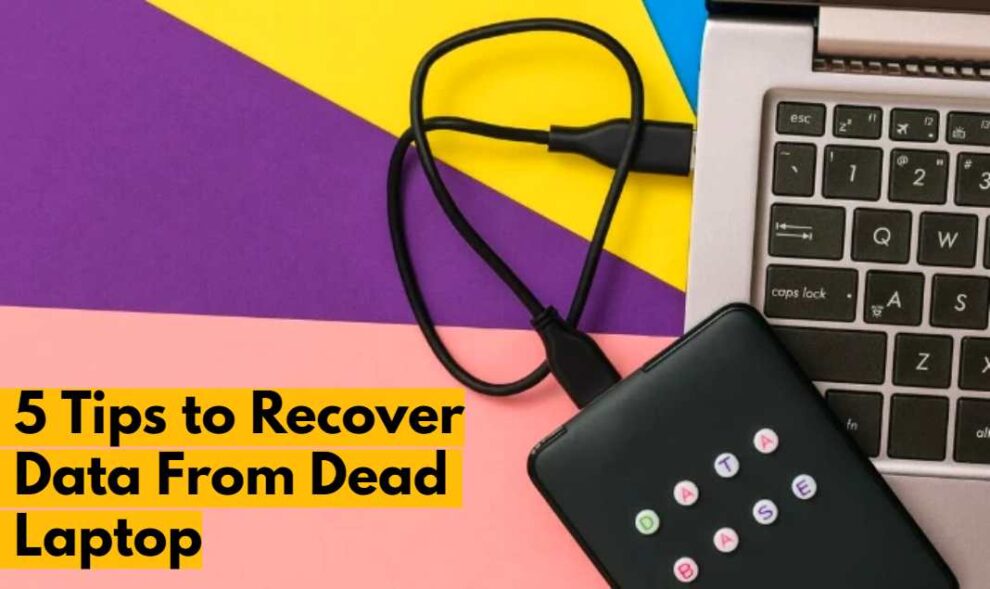A dead laptop is not a common issue. Not many laptop users encounter this harsh problem every day, like other common laptop issues. If the dead laptop is not due to hardware failures, the next possible cause is software problems.
Now, the most disturbing thing about a dead laptop is its content. All the data and files that users usually store in a laptop hard drive are pretty important. If there is no backup, one might end up losing all the data in it. But a dead laptop is no big deal if there is a backup of everything on the system.
Speaking of that, retrieving data and files from a deal laptop is a task that every ordinary user may not know. Hence, here are the top five practical and simple ways to recover data from a dead laptop. If you somehow end up with a dead computer at any time, follow these data recovery tips.
Seeing your laptop dead when you need it the most can be pretty unfortunate. You cannot correctly reboot your device or attempt any successful start-ups as it will shut down repeatedly.
Since the issue of a dead laptops is increasing, there are also many data recovery software that you can use. You can find this software in paid and free versions as well. The data on a laptop is usually stored on a hard drive. So, a dead laptop with software failure will still keep the data on the hard drive safe. But for a hardware failure, the situation would be critical.
Nonetheless, we shall now see the five data recovery solutions from a dead laptop (Windows).
Tip 1: By booting the laptop into Safe Mode
This is the simplest way to try recovering the data from a dead laptop. You can try booting your device in Safe Mode. This Mode is a built-in diagnostic Mode for Windows 7, 8, 8.1, and 10 OS. Safe Mode is used for:
- Identifying and fixing fundamental laptop software problems.
- Recovering data from the laptop’s internal hard disk drive (HDD) to an external hard drive.
Entering the laptop in Safe Mode is different for different versions of OS.
- For Windows 7 and older versions – Press the F8 key or ‘Windows + R” keys.
- For Windows 8 – Press the “Shift + F8” keys combined or simply F8.
- For Windows 8.1 and 10 – Press the “Restart + Shift” keys.
If Safe Mode does not work, use “Windows Explorer” to copy data and files to an external drive.
Tip 2: From Cloud backup
If you use Cloud backup on your laptop, there is nothing much to worry about. Cloud backup is the safest way to store any data. Even if you lose the device, you will have your Cloud account to access the data.
Now, having the Cloud backup on the HDD of the dead laptop is not impossible to recover. Take another computer and, log in to your Cloud account, check the data that you want to recover. Take an external hard drive to transfer and save the recovered data. If you repair or buy a new laptop, you can transfer the data back to the device.
Tip 3: Remove the HDD/SSD/NVMe and use it on another laptop
Suppose the laptop is not turning on, and no other resolution applies to it. In that case, you can remove its storage device and transplant it to another laptop. Based on your laptop, the storage device could be an SSD, an HDD, or an NVMe.
After you remove the storage device from the dead laptop:
- Take a SATA-USB to use as an external tool.
- If the SATA-USB adapter is incompatible, get the PATA or IDE-supporting interface.
- Insert the SSD or HDD into the SATA-USB and connect to another working laptop. The drive will serve as an external tool for the other laptop.
Now, launch the “Disk Management Utility” tool on the laptop. For that, open the “Run” window by pressing the “Windows + R” keys together. Then, enter “diskmgmt. MSC” in the given space to get what you need. Now, follow the steps below:
- Right-click on the external HDD and click on the “Change Drive Letters and Paths” options.
- Select “Add/Change” to change to the desired drive Letter and hit the “OK” button.
Do not accidentally format the drive here. As soon as you access the data, copy them to the laptop’s system.
Tip 4: Use an external flash drive or CD to boot
This solution applies to Linux OS. If putting the vulnerable laptop in Safe Mode did not help you recover any data, you can try booting the system using a USB, DVD, or Live CD. Since you will use the flash drive again in the future, better use a bootable USB instead of a CD. Furthermore, optical drives are vulnerable to damage and do not apply to most modern laptops.
Tip 5: Using Windows Installation disk to booth device
Most dead laptops have their Windows installation destroyed. So, you can use a Windows Installation disc to recover the data and files. Here’s the process to do so:
- Connect the Windows installation disk to the dead laptop and try turning it on.
- As the device start-up, a message will be displayed stating, “Press any Key to boot from CD or DVD.”
- Press the “Next” > “Repair Your Computer.”
- If you are using a Windows 10 0r eight installation disk, choose to Troubleshoot > Advanced Options > Command Prompt.
- As the Command Prompt opens, type “Notepad” in the space and hit the “Enter” button.
- In the Notepad dialog box, select “File” > “Open” > “All Files” > “Computer.”
You can now use the “Open” dialog box acting as the Windows Explorer window. Copy the needed data to the external drive for recovery.
These are the five simple and practical tips to recover data from a dead laptop. If these fixes don’t work, you can go for a reliable and working data recovery tool. If possible, you can have your dead repaired too.



















Add Comment